Cosmological Research with IRIS Explorer
Ue-Li
Pen, the Center for Astrophysics in Cambridge, Massachusetts
The Center for Astrophysics in Cambridge, Massachusetts use IRIS
Explorer to explore the origin and evolution of the universe
Ue-Li Pen, Ph.D., a theoretical cosmologist with The Center for
Astrophysics in Cambridge, Mass., is exploring the origin and
evolution of the universe with extremely large-scale computer
simulations. In his office and laboratory in the Center, which is
operated jointly by the Smithsonian Institution and the Harvard
College Observatory, he and his associates perform research into
all areas of astrophysics.
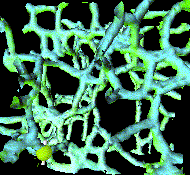 Pen specializes in the origin and the structure of the universe,
particularly on how objects within the universe form, as opposed
to how the universe itself was formed. As he explains it, such
basic research furthers scientific understanding into traditional
questions such as, Why do the stars exist? Why do galaxies exist?
and Where did we come from?
Pen specializes in the origin and the structure of the universe,
particularly on how objects within the universe form, as opposed
to how the universe itself was formed. As he explains it, such
basic research furthers scientific understanding into traditional
questions such as, Why do the stars exist? Why do galaxies exist?
and Where did we come from?
Pen has chosen IRIS Explorer running on a DEC 300 workstation
as his visualization tool of choice.
"In our work, we create three-dimensional simulations of gas
dynamics and N-body systems," Pen says. "An N-body system - a
system of collisionless particles - is what we believe the so-
called dark (in the sense that one doesn't really see it directly)
matter of the universe is made of. And since they're 3D simulations,
we need some fairly fancy and sophisticated software."
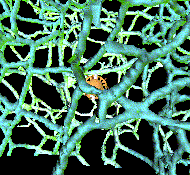 Fancy and sophisticated enough to handle the team's large datasets -
typically about a 1283 curvilinear lattice. They are created when
he and his team write code, run it on another machine, then process
the resulting datasets through IRIS Explorer. At this point, the
NAG software helps him visualize the three-dimensional datasets.
Fancy and sophisticated enough to handle the team's large datasets -
typically about a 1283 curvilinear lattice. They are created when
he and his team write code, run it on another machine, then process
the resulting datasets through IRIS Explorer. At this point, the
NAG software helps him visualize the three-dimensional datasets.
The size of the boxes they simulate is described as being about
100 megaparsecs. The smallest dataset is estimated to be about 10
megabytes. "It's as though we're looking through a telescope that
can see 350 million light years," Pen says.
Pen's main use for IRIS Explorer, of course, is to help understand
how the universe evolved. He's also found that it can do what his
team calls numerical experimentation, and it can help debug
datasets and programs.
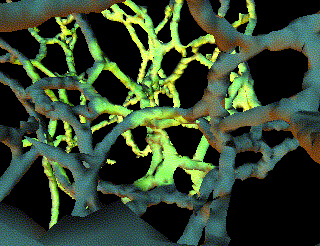 Using routines such as IsosurfaceContour, the Harvard research
team has created a huge space ship that it can move at enormous
speed - much faster than the speed of light. "We can actually
whiz into deep space and walk around as though we're space
travelers," he says. "The evolution of the universe is fairly
difficult to measure using telescopes. But using IRIS Explorer is
like having a telescope in our universe simulation. We can virtually
fly out into outer space and examine things."
Using routines such as IsosurfaceContour, the Harvard research
team has created a huge space ship that it can move at enormous
speed - much faster than the speed of light. "We can actually
whiz into deep space and walk around as though we're space
travelers," he says. "The evolution of the universe is fairly
difficult to measure using telescopes. But using IRIS Explorer is
like having a telescope in our universe simulation. We can virtually
fly out into outer space and examine things."
For work like this, visualization software must be an interactive
tool - and "interactive" is a key term, Pen says. He believes
that researchers must be able to manipulate the data they're looking
at. At times, they may want to see a large area, and at other times,
just a small piece of it. They also need to be able to change their
viewpoint easily.
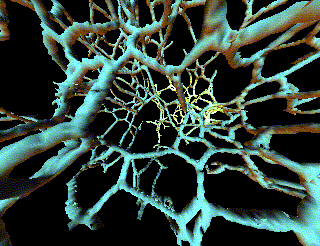 His current area of study concerns the core sizes of clusters of
galaxies. He states that what are sometimes referred to as
"clusters of galaxies" are actually collections of hundreds of
galaxies. These clusters have a core size to them, but the exact
size was unknown until the team ran core simulations with the software.
"Being able to calculate their size with IRIS Explorer is quite an
event," he says.
His current area of study concerns the core sizes of clusters of
galaxies. He states that what are sometimes referred to as
"clusters of galaxies" are actually collections of hundreds of
galaxies. These clusters have a core size to them, but the exact
size was unknown until the team ran core simulations with the software.
"Being able to calculate their size with IRIS Explorer is quite an
event," he says.
With the 3D visualization software, another interesting task the
team can do with the data is what they call "numerical experimen-
tation." This involves controlled experiments that change the physics
of the universe, and then the results can be observed on the computer
screen.
According to Pen, the capability for numerical experimentation did
not exist with any other package he has investigated. While many
packages offer static plotting, they simply allow users to statically
create a given projection of a given dataset. But that's all.
Another difficulty with other visualization software is that other
packages may not be able to simulate the volume that goes with looking
at 350 million light years of data.
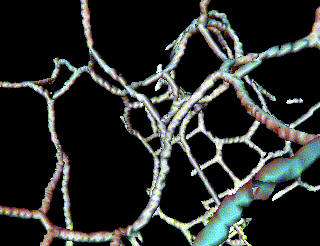 Accuracy is, of course, an extremely important element in scientific
and engineering studies such as these. IRIS Explorer includes modules
built on sophisticated algorithms from NAG numerical libraries, known
for accuracy and reliability. The use of these libraries can save a
developer time and effort in implementing fundamental algorithms and
allows concentration on other aspects of the visualization process.
Users can be confident that all modules have been used in a very wide
range of other applications. In addition, the libraries provides ready-
made reference for documentation purposes, key to assessing the accuracy
and applicability of the module.
Accuracy is, of course, an extremely important element in scientific
and engineering studies such as these. IRIS Explorer includes modules
built on sophisticated algorithms from NAG numerical libraries, known
for accuracy and reliability. The use of these libraries can save a
developer time and effort in implementing fundamental algorithms and
allows concentration on other aspects of the visualization process.
Users can be confident that all modules have been used in a very wide
range of other applications. In addition, the libraries provides ready-
made reference for documentation purposes, key to assessing the accuracy
and applicability of the module.
"There is a whole zoo of visualization packages out there, and I have
tried many of them, from the very popular to the less well-known. The
decisive factors for us were the affordability of IRIS Explorer, and
its ease of use. It is powerful yet basic, not dedicated to any
particular type of research."
The Center for Astrophysics team disseminates its information widely.
Their work and visualizations frequently are presented in papers and
at conferences on cosmology, at various astronomical institutes and at
the American Astronomical Society.
IRIS Explorer accelerates the speed of the team's work, and it makes it
easy for them to show their work and its results to non-experts.
"Without IRIS Explorer, it would be very hard to describe what we
do," Pen says.
Last modified: Fri Feb 14 10:02:49 1997
[ Posters Home ]
© The Numerical Algorithms Group Ltd, Oxford UK, 1996.
 Pen specializes in the origin and the structure of the universe,
particularly on how objects within the universe form, as opposed
to how the universe itself was formed. As he explains it, such
basic research furthers scientific understanding into traditional
questions such as, Why do the stars exist? Why do galaxies exist?
and Where did we come from?
Pen specializes in the origin and the structure of the universe,
particularly on how objects within the universe form, as opposed
to how the universe itself was formed. As he explains it, such
basic research furthers scientific understanding into traditional
questions such as, Why do the stars exist? Why do galaxies exist?
and Where did we come from?
 Fancy and sophisticated enough to handle the team's large datasets -
typically about a 1283 curvilinear lattice. They are created when
he and his team write code, run it on another machine, then process
the resulting datasets through IRIS Explorer. At this point, the
NAG software helps him visualize the three-dimensional datasets.
Fancy and sophisticated enough to handle the team's large datasets -
typically about a 1283 curvilinear lattice. They are created when
he and his team write code, run it on another machine, then process
the resulting datasets through IRIS Explorer. At this point, the
NAG software helps him visualize the three-dimensional datasets.
 Using routines such as IsosurfaceContour, the Harvard research
team has created a huge space ship that it can move at enormous
speed - much faster than the speed of light. "We can actually
whiz into deep space and walk around as though we're space
travelers," he says. "The evolution of the universe is fairly
difficult to measure using telescopes. But using IRIS Explorer is
like having a telescope in our universe simulation. We can virtually
fly out into outer space and examine things."
Using routines such as IsosurfaceContour, the Harvard research
team has created a huge space ship that it can move at enormous
speed - much faster than the speed of light. "We can actually
whiz into deep space and walk around as though we're space
travelers," he says. "The evolution of the universe is fairly
difficult to measure using telescopes. But using IRIS Explorer is
like having a telescope in our universe simulation. We can virtually
fly out into outer space and examine things." His current area of study concerns the core sizes of clusters of
galaxies. He states that what are sometimes referred to as
"clusters of galaxies" are actually collections of hundreds of
galaxies. These clusters have a core size to them, but the exact
size was unknown until the team ran core simulations with the software.
"Being able to calculate their size with IRIS Explorer is quite an
event," he says.
His current area of study concerns the core sizes of clusters of
galaxies. He states that what are sometimes referred to as
"clusters of galaxies" are actually collections of hundreds of
galaxies. These clusters have a core size to them, but the exact
size was unknown until the team ran core simulations with the software.
"Being able to calculate their size with IRIS Explorer is quite an
event," he says.  Accuracy is, of course, an extremely important element in scientific
and engineering studies such as these. IRIS Explorer includes modules
built on sophisticated algorithms from NAG numerical libraries, known
for accuracy and reliability. The use of these libraries can save a
developer time and effort in implementing fundamental algorithms and
allows concentration on other aspects of the visualization process.
Users can be confident that all modules have been used in a very wide
range of other applications. In addition, the libraries provides ready-
made reference for documentation purposes, key to assessing the accuracy
and applicability of the module.
Accuracy is, of course, an extremely important element in scientific
and engineering studies such as these. IRIS Explorer includes modules
built on sophisticated algorithms from NAG numerical libraries, known
for accuracy and reliability. The use of these libraries can save a
developer time and effort in implementing fundamental algorithms and
allows concentration on other aspects of the visualization process.
Users can be confident that all modules have been used in a very wide
range of other applications. In addition, the libraries provides ready-
made reference for documentation purposes, key to assessing the accuracy
and applicability of the module.